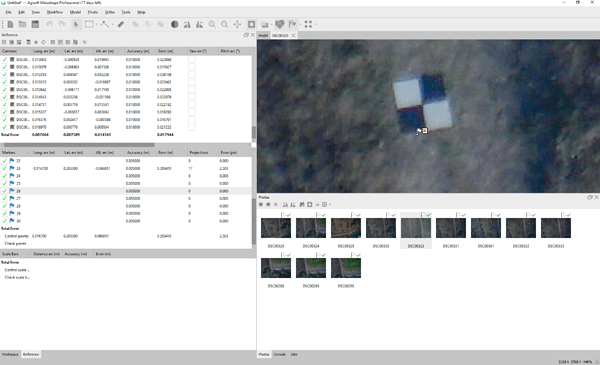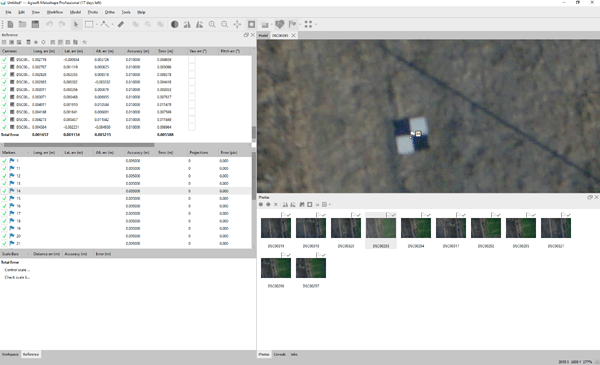Heading hold only make the drone not turn in yaw direction. So in grid pattern camera orientation don’t change. What it change is the pitch of the drone. when the drone is moving forward and backward camera pitch change from e.g 7 degrees to -7 degrees.But as i said with the antenna 15 cm over camera lens that shouldn’t cause an error larger than 2.5 cm. In my phantom the antenna is 21 cm over the camera and i don’t have these errors.
Ok, so your drone doesnt turn but fly backwards then?
Yes exactly.
But as i said in any case that error is not big.
Where/how is this transformation done ?
The transformation was made with a local software. It applies seven parameter transformation and extra shift grid corrections and a geoid correction for heights. Both cameras positions and GCP grid coordinates computed with the same transformation. In the metashape I import directly grid coordinates. So there is no problem in this field. I know what I am doing.
Can you try just keeping the whole thing in WGS84 ?
It’s the same. It’s not that the problem
So here you are
Its the same.
If you apply the same transformation in camera position and GCPs there is no problem. Problem would be to apply my transformation in GCPs and let Metashape apply a simpler 3 parameter transformation in Camera Positions. Then i would compare apples with oranges. But not in my case. I compare apples with apples.
I am sure its something with camera settings.
Metashape has an option for correcting rolling sutter.
My camera hat mechanical shutter if i dont make a huge mistake. But if i enable that and align again see the results
But in another flight by enable this the marker went not in the center of GCP but in the opposite edge. So my conclusion is that i have a synchronization problem.
I have seen a lot of people have this camera in the forum. I hope someone will help.
Your camera has a mechanical and a electronic front curtain shutter.
The latter one can be on or off. Could you please check if this is off?
Here is a yt clip showing where to find it.
I have found no difference between the EFC (electronic front curtain) and the mechanical shutter, have you? I think it will just save me shutter cycles. I can’t detect any more rolling shutter effects from it.
How are you detecting the difference?
The best way is to do identical missions and process them identically.
There is little or no details/data on when the flash signal is output during an exposure.
Its mearly in the beginning, midle or in the end and thats it.
But we need ms in PPK and that isnt most camera built for.
With electronic front curtain shutter, the sensor is exposed before the images is taken and not like in normal mode whit the curtain slides in the front of the sensor.
This might be enough to trigger the flash slightly different.
My point is to give it a try in manual mode, with EFCS off, and try different flash mode.
You can definitely give things a try, but my data shows that EFC doesn’t change anything. It seems to turn on the sensor at the exact moment that the front curtain would have.
All of this is kind is kind of pushing the limits on accuracy at 20 m/s. Considering the shutter takes roughly 2ms to traverse the sensor, that’s 5cm at 20m/s. As long as we’re consistent, we can take that into account, but you can see that this will start to affect projects with GSD below 2.5cm.
Ah sorry, i thought i was replying to TS.
But you have teste both settings and dont have the offset TS is referring to?
Shooting manual?, fill flash? Other setup
Are you using rolling shutter compensation when processing?
What speed/height are you flying?
Yes, i would agree, its not likely the shutter closing the exposure causing the delay. Even though the mechanical shutter is closing the exposure and the rollig shutter effect is present, the error is really smal. Not sure what speed the shutter passes the sensor but 20-30ms sounds plausible.
My thoughts where if the triggering signal to the flash is changed with the EFCS on or off, but if tested i guess this is a dead end to throubleshoot further.
I made today 4 flights. Two with rear synk flash and two different lenses, one with slow sync and one with fill synk. I just finished a hurry test with all data. Same results. I am not sure if one of them is better from the other. But the results are not good.
My partner flied again with phantom yesterday. Perfect results.
I really don’t know what else to do.
Did you try different speed?
I was flying with 7m/sec. As I have seen other flies with plane which is something I also want to do. Plane is not able to fly with this speed.
I was thinking it would be easier to identify your issue if you had different speed. A higher speed would give greater error if its a sync problem.
You are right. I didn’t think about it.
What results do you have with your modified Samsung? I think you are flying with a plane.
The reason for my point is the true speed of the shutter leaf. Exposure is one thing, but the speed of the shutter leaf crossing the sensor is just 1/300 ish of a seconds (for most modern mechanical shutters).
This must not be confused with shutterspeed (exposure time).
You would be thinking, hey! I is just use 1/2000, that should do the trick and freeze the image. Errh… That is not entirely true, cus its exposure time, not motion time.
You camera is actually “freezing” images at about 1/300 of a second which with your speed at about 7-8ms would give you an error of 20-25cm
Thats is why a global shutter is sometimes better, it opens and closes all pixels at once, but not as fast as 1/8000 sec.
My plane has been hijacked by the DoD because its so awesomely built ![]()







